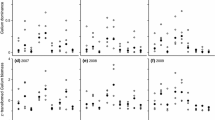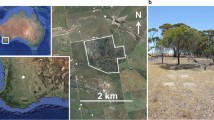Abstract
Invasion by exotic plant species can profoundly affect native plant species performance and the inferred proximate cause is typically competition. We used invaded grasslands in the semi-arid Western USA to separate resource competition from structural interference of an exotic grass on native forb performance, specifically evaluating the role of competition from living vegetation versus litter accumulation (hereafter, thatch). We simultaneously tested whether a positive thatch-feedback exists for the dominant exotic grass species, Bromus diandrus. Thatch and B. diandrus density were manipulated and coupled with native seed addition to separate the effect of B. diandrus competition relative to thatch accumulation. To determine the response of native forb species and B. diandrus to varying thatch abundance, we created a gradient of thatch densities and measured species response, soil moisture and light availability. The thatch of B. diandrus greatly reduced native forb performance (number of individuals and biomass) and resulted in near complete exclusion of many species. The effect of living B. diandrus density on native forb performance was minimal and inconsistent. Forb performance and light availability both exhibited exponential declines with thatch build-up suggesting that light reduction is a primary mechanism through which thatch affects forbs. Simultaneous with forb suppression, B. diandrus performance was positively affected by thatch, consistent with a positive feedback initiated by invasion of this species. Our results demonstrate that thatch accumulation, rather than competition for resources, is the primary cause of native species decline in grasslands invaded by this exotic annual grass. In addition, the dominance of B. diandrus in many invaded grasslands may be reinforced through a positive thatch-feedback and require active management, such as grazing or fire, to be broken.





Similar content being viewed by others
References
Abraham JK, Corbin JD, D’Antonio CM (2009) California native and exotic perennial grasses differ in their response to soil nitrogen, exotic annual grass density, and order of emergence. Plant Ecol 201:445–456
Amatangelo KL, Dukes JS, Field CB (2008) Responses of a California annual grassland to litter manipulation. J Veg Sci 19:605–612
Bartolome JW, Stroud MC, Heady HF (1980) Influence of natural mulch on forage production on differing California annual range sites. J Range Manag 33:4–8
Bartolome J, Jackson R, Betts A et al (2007) Effects of residual dry matter on net primary production and plant functional groups in Californian annual grasslands. Grass Forage Sci 62:445–452
Beatley JC (1974) Phenological events and their environmental triggers in Mojave Desert ecosystems. Ecology 55:856–863
Beckstead J, Meyer SE, Connolly BM et al (2010) Cheatgrass facilitates spillover of a seed bank pathogen onto native grass species. J Ecol 98:168–177
Beckstead J, Miller LE, Connolly BM (2012) Direct and indirect effects of plant litter on a seed–pathogen interaction in Bromus tectorum seed banks. Seed Sci Res 22:135–144
Bossard CC, Randall JM (2007) Nonnative plants of California. Terrestrial vegetation of California, 3rd edn. University of California Press, Berkeley, pp 107–123
Carson WP, Peterson CJ (1990) The role of litter in an old-field community: impact of litter quantity in different seasons on plant species richness and abundance. Oecologia 85:8–13
Chen B-M, D’Antonio CM, Molinari N et al (2018) Mechanisms of influence of invasive grass litter on germination and growth of coexisting species in California. Biol Invasions 20:1881–1897
Coleman HM, Levine JM (2007) Mechanisms underlying the impacts of exotic annual grasses in a coastal California meadow. Biol Invasions 9:65–71
Corbin J, Dyer A, Seabloom E (2007) Competitive interactions. California grasslands: ecology and management. University of California Press, Berkeley, pp 156–168
Cox RD, Allen EB (2008) Stability of exotic annual grasses following restoration efforts in southern California coastal sage scrub. J Appl Ecol 45:495–504
Dangremond EM, Pardini EA, Knight TM (2010) Apparent competition with an invasive plant hastens the extinction of an endangered lupine. Ecology 91:2261–2271
Dibblee TW (1966) Geology of the Central Santa Ynez Mountains, Santa Barbara County, California. California Division of Mines and Geology, Sacramento
Dyer AR, Rice KJ (1999) Effects of competition on resource availability and growth of a California bunchgrass. Ecology. 80:2697–2710
Ehrenfeld JG (2010) Ecosystem consequences of biological invasions. Annu Rev Ecol Evol Syst 41:59–80
Eppinga MB, Kaproth MA, Collins AR et al (2011) Litter feedbacks, evolutionary change and exotic plant invasion. J Ecol 99:503–514
Evans RA, Young JA (1970) Plant litter and establishment of alien annual weed species in rangeland communities. Weed Sci 18:697–703
Facelli JM (1994) Multiple indirect effects of plant litter affect the establishment of woody seedlings in old fields. Ecology 75:1727–1735
Facelli JM, Pickett STA (1991) Plant litter: its dynamics and effects on plant community structure. Bot Rev 57:1–32
Facelli JM, Williams R, Fricker S et al (1999) Establishment and growth of seedlings of Eucalyptus obliqua: interactive effects of litter, water, and pathogens. Aust J Ecol 24:484–494
Farrer EC, Goldberg DE (2009) Litter drives ecosystem and plant community changes in cattail invasion. Ecol Appl 19:398–412
Fernandez-Going BM, Anacker BL, Harrison SP (2012) Temporal variability in California grasslands: soil type and species functional traits mediate response to precipitation. Ecology 93:2104–2114
Foster BL, Gross KL (1997) Partitioning the effects of plant biomass and litter on Andropogon gerardi in old-field vegetation. Ecology 78:2091–2104
Foster BL, Gross KL (1998) Species richness in a successional grassland: effects of nitrogen enrichment and plant litter. Ecology 79:2593–2602
Gioria M, Osborne BA (2014) Resource competition in plant invasions: emerging patterns and research needs. Front Plant Sci 5:501
Goldberg DE, Werner PA (1983) The effects of size of opening in vegetation and litter cover on seedling establishment of goldenrods (Solidago spp.). Oecologia 60:149–155
Gordon D, Rice K (1992) Partitioning of space and water between two California annual grassland species. Am J Bot 79:967–976
Grime JP, Mason G, Curtis AV et al (1981) A comparative study of germination characteristics in a local flora. J Ecol 69:1017–1059
Grime JP, Brown VK, Thompson K et al (2000) The response of two contrasting limestone grasslands to simulated climate change. Science 289:762–765
Gross KL, Werner PA (1982) Colonizing abilities of ‘biennial’ plant species in relation to ground cover: implications for their distributions in a successional sere. Ecology 63:921–931
Hayes GF, Holl KD (2003) Cattle grazing impacts on annual forbs and vegetation composition of mesic grasslands in California. Conserv Biol 17:1694–1702
Heady HF (1958) Vegetational changes in the California annual type. Ecology 39:402–416
HilleRisLambers J, Yelenik SG, Colman BP et al (2010) California annual grass invaders: The drivers or passengers of change? J Ecol 98:1147–1156
Jensen K, Gutekunst K (2003) Effects of litter on establishment of grassland plant species: the role of seed size and successional status. Basic Appl Ecol 4:579–587
Knapp AK, Seastedt TR (1986) Detritus accumulation limits productivity of tallgrass prairie. Bioscience 36:662–668
Larson F, Whitman W (1942) A comparison of used and unused grassland mesas in the badlands of South Dakota. Ecology 23:438–445
Lenz TI, Moyle-Croft JL, Facelli M (2003) Direct and indirect effects of exotic annual grasses on species composition of a South Australian grassland. Austral Ecol 28:23–32
Levine JM, Vila M, Antonio CMD et al (2003) Mechanisms underlying the impacts of exotic plant invasions. Proc R Soc Lond B 270:775–781
Liao C, Peng R, Luo Y et al (2008) Altered ecosystem carbon and nitrogen cycles by plant invasion: a meta-analysis. New Phytol 177:706–714
Mack MC, D’Antonio CM (1998) Impacts of biological invasions on disturbance regimes. Trends Ecol Evol 13:195–198
Malmstrom CM, McCullough AJ, Johnson HA et al (2005) Invasive annual grasses indirectly increase virus incidence in California native perennial bunchgrasses. Oecologia 145:153–164
McCown RL, Williams WA (1968) Competition for nutrients and light between the annual grassland species Bromus mollis and Erodium botrys. Ecology 49:981–990
Meisner A, De Boer W, Cornelissen JH et al (2012) Reciprocal effects of litter from exotic and congeneric native plant species via soil nutrients. PLoS ONE 7:e31596
Menke JW (1992) Grazing and fire management for native perennial grass restoration in California grasslands. Fremontia 20:22–25
Meyer MD, Schiffman PM (1999) Fire season and mulch reduction in a California grassland: a comparison of restoration strategies. Madrono 46:25–37
Minnich RA (2008) California’s fading wildflowers: lost legacy and biological invasions. University of California Press, Berkeley
Molinari NA, D’Antonio CM (2014) Structural, compositional and trait differences between native and non-native dominated grassland patches. Funct Ecol 28:745–754
Mordecai EA (2012) Soil moisture and fungi affect seed survival in California grassland annual plants. PLoS ONE 7:e39083
Orrock JL, Witter MS, Reichman OJ (2008) Apparent competition with an exotic plant reduces native plant establishment. Ecology 89:1168–1174
Perkins LB, Nowak RS (2013) Native and non-native grasses generate common types of plant–soil feedbacks by altering soil nutrients and microbial communities. Oikos 122:199–208
Pitt MD, Heady HF (1978) Responses of annual vegetation to temperature and rainfall patterns in northern California. Ecology 59:336–350
Rundel PW, Gibson AC (2005) Ecological communities and processes in a Mojave Desert ecosystem. Cambridge University Press, Cambridge
Seabloom EW, Harpole WS, Reichman OJ et al (2003) Invasion, competitive dominance, and resource use by exotic and native California grassland species. Proc Natl Acad Sci 100:13384
Stahlheber KA, D’Antonio CM (2013) Using livestock to manage plant composition: a meta-analysis of grazing in California Mediterranean grasslands. Biol Conserv 157:300–308
Suding KN, Gross KL, Houseman GR (2004) Alternative states and positive feedbacks in restoration ecology. Trends Ecol Evol 19:46–53
Tilman D, Wedin D (1991) Oscillations and chaos in the dynamics of a perennial grass. Nature 353:653–655
Vilà M, Espinar JL, Hejda M et al (2011) Ecological impacts of invasive alien plants: a meta-analysis of their effects on species, communities and ecosystems. Ecol Lett 14:702–708
Willms W, Smoliak S, Bailey A (1986) Herbage production following litter removal on Alberta native grasslands. J Range Manag 39:536–540
Wolkovich EM, Bolger DT, Cottingham KL (2009) Invasive grass litter facilitates native shrubs through abiotic effects. J Veg Sci 20:1121–1132
Zavaleta ES, Shaw MR, Chiariello NR et al (2003) Additive effects of simulated climate changes, elevated CO2, and nitrogen deposition on grassland diversity. Proc Natl Acad Sci 100:7650–7654
Acknowledgements
We thank Viviane Vincent, Jono Wilson, Alex Zucker, Nicole Nomany, Zac Lu, Mac Wing, Josh Cohen and Maureen Isaacs for their help in the field and lab; Bruce Mahall, Jonathan Levine, Sara Kuebbing, and two anonymous reviewers for comments that improved the manuscript; and Kate McCurdy for providing logistical support at Sedgwick Reserve.
Funding
The project was supported by the Mildred Mathias University of California, Natural Reserve Fellowship and the California Native Plant Society.
Author information
Authors and Affiliations
Corresponding author
Ethics declarations
Conflict of interest
The authors declare that they have no conflict of interest.
Additional information
Publisher's Note
Springer Nature remains neutral with regard to jurisdictional claims in published maps and institutional affiliations.
Electronic supplementary material
Below is the link to the electronic supplementary material.
Rights and permissions
About this article
Cite this article
Molinari, N.A., D’Antonio, C.M. Where have all the wildflowers gone? The role of exotic grass thatch. Biol Invasions 22, 957–968 (2020). https://doi.org/10.1007/s10530-019-02135-1
Received:
Accepted:
Published:
Issue Date:
DOI: https://doi.org/10.1007/s10530-019-02135-1




